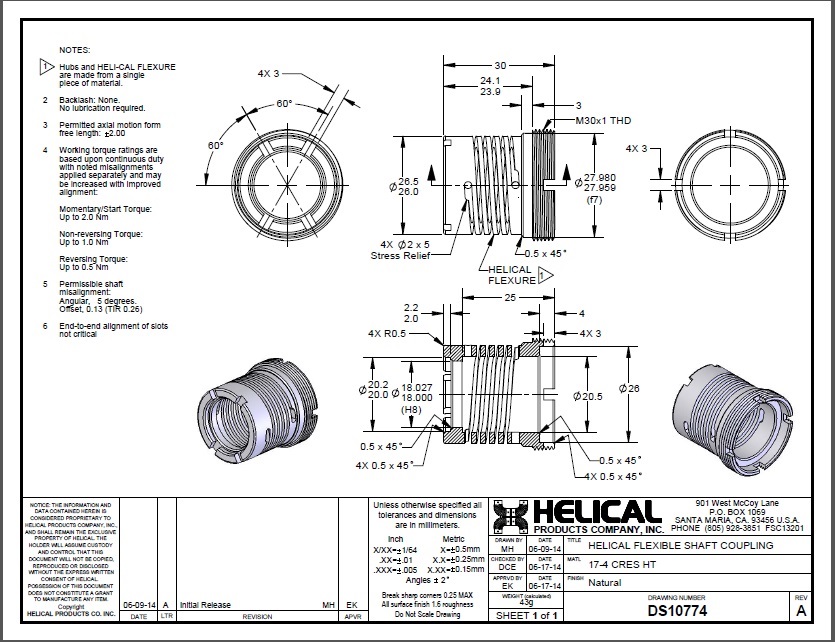By Mike Santora
“If it ain’t broke, don’t fix it”— an old phrase perhaps most appropriate in reference to the coupling selection for a future design. With time constraints moving at the speed of commerce, designers go with what they know has worked in the past. That’s a legitimate argument. Plus, there is no reason to over-engineer the simple answer. However, there are certain circumstances where a custom coupling might mean the difference between a good choice, and the perfect choice. To help us recognize the difference, we spoke with Randy Kingsbury, mechanical engineer and vice president of sales and marketing at Helical Products Company.
Design World: Can you tell us about some of the ways engineers can simplify machine assembly from the start?
Randy Kingsbury: “We work all the time with applications engineers, and what we’ve found is that they’re using our catalog and trying to figure out the best way to fit our catalog coupling into their application. When they call, we review the application. We find that we can actually choose a better solution for them by designing a custom coupling. They’re often surprised that a custom coupling doesn’t necessarily mean more expensive. With custom, we can incorporate certain features and attachments that will optimize it for their application.”
DW: It would be nice if we could design from within a funding vacuum where price does not matter, but that’s almost never the case. In relation to cost, when are custom couplings the best choice and when are they not?
RK: “The one thing I can say is our most expensive part is a custom part and our least expensive part is also a custom part. That gives some perspective that it doesn’t necessarily mean it’s going to be more expensive. The key is going into an application and looking if there’s other features or components that can be integrated into a coupling. When you do that, rather than buying a standard coupling and buying the associated components that maybe mount on either side of it, all these components can be machined into one solution.”
DW: Can you give us examples of other components?
RK: “We have machined specialty shaft shapes, flanges, gears, lever arms and more into a single piece solution so the customer does not have to buy a standard coupling and manufacture those additional components. Customers are looking to manage their efficiencies by having a part where they are combining two, three, four or more parts. This saves an engineer from managing many separate drawings, quotes and purchases from several vendors. Additionally, there is the savings of not having to invest manpower in assembling the various parts because the custom coupling is ready to drop into the assembly.”
DW: Outside of the cost and value assessment, often the choice is an oversized coupling. What options are available to avoid oversizing?
RK: “When people are trying to stick with a catalog part, they might find that the coupling has an inch and a quarter outside diameter and doesn’t have enough torque capacity. They have to jump up quite a bit in size. What happens is the engineer ends up with a coupling that’s more expensive and too large. It can also be heavier with more inertia than they actually require because the next size down is too small. Instead, engineers can have a custom coupling with the exact size and torque capacity required.”
DW: How has designing custom couplings changed recently?
RK: “Machining technology has truly pushed things forward. You can now machine more difficult features and hold tighter tolerances. The ability to machine specialty materials has greatly improved with the current machining technology.”
DW: How do operating conditions impact an engineer’s choice of materials?
RK: “This is a situation when trying to stay with a standard part can mean compromises. Certainly thermal variances can be an issue. A good example that we run into is high temperature. We use 17-4 steel, which is a great, high-strength material. In certain applications, somebody may need something that has even better high-temperature capacity and that would be an Inconel material. With that, rather than trying to use the 17-4 and get that to work, we can look at other alternative materials that are better.”
DW: Can you tell us a little more about alternate materials and maybe some applications?
RK: “Application examples would be downhole drilling and medical tools. Both involve highly corrosive environments. For drilling, we might look into an MP35N cobalt alloy option, which is very corrosion resistant. For medical tools and components that have been implanted in the body, custom choices are often needed. We might choose aluminum or 303, which is actually not a very high-strength material. When you get into things related to the body, often, MP35N and even titanium is used.”
DW: How is the weight of a material factored into the equation?
RK: “Well, weight is especially important in the aviation or space industry. Frequently, aluminum doesn’t have the strength. Titanium is frequently an excellent solution.”
DW: We mentioned the need to get to market fast earlier, but there is also the issue of competition. Can custom components help protect the intellectual property of a design?
RK: “Manufacturing a custom coupling that has unique features can simplify installation, inventory and help prevent reverse engineering. A competitive company will not be able to replicate another company’s design just by ordering standard parts and piecing them together. This creates a significant barrier to reverse engineering. The ability to machine specialty materials and provide a flexible element uniquely tailored to an application means the best coupling performance is packaged in the minimum possible space. If a competitor tries to duplicate a design and use off the shelf parts it will likely require a coupling larger than the customized one to meet the necessary torque and misalignment. Reverse engineering is a global phenomenon. It can happen here. It can happen overseas. It can happen everywhere.”
Helical
